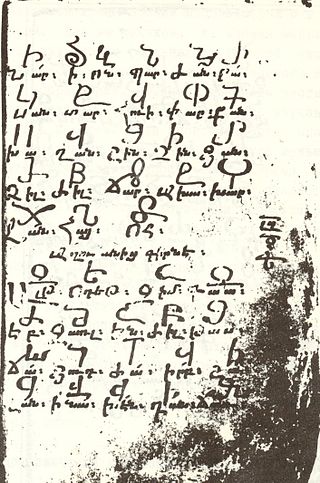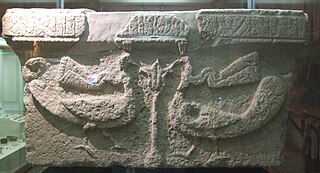
Gregory the Illuminator was the founder and first official head of the Armenian Apostolic Church. He converted Armenia from Zoroastrianism to Christianity in the early fourth century, making Armenia the first state to adopt Christianity as its official religion. He is venerated as a saint in the Armenian Apostolic Church and in some other churches.

Caucasian Albania is a modern exonym for a former state located in ancient times in the Caucasus, mostly in what is now Azerbaijan. The modern endonyms for the area are Aghwank and Aluank, among the Udi people, who regard themselves as descended from the inhabitants of Caucasian Albania. However, its original endonym is unknown.

Isaac or Sahak of Armenia was the catholicos of the Armenian Church from c. 387 until c. 438. He is sometimes known as Isaac the Great or Sahak the Parthian in reference to his father's Parthian origin. He was the last Armenian patriarch who was directly descended from Gregory the Illuminator, who converted the Kingdom of Armenia to Christianity in the early fourth century and became the first head of the Armenian Church. He supported Mesrop Mashtots in the creation of the Armenian alphabet and personally participated in the translation of the Bible into Armenian.

Nerses I the Great, also known as Nerses the Parthian, was an Armenian Catholicos who lived in the fourth century.

Saint Pantaleon, counted in Western Christianity as among the Fourteen Holy Helpers of the Late Middle Ages, and in Eastern Christianity as one of the Holy Unmercenary Healers, was a martyr of Nicomedia in Bithynia during the Diocletianic Persecution of 305 AD.

Amaras Monastery is an Armenian monastery near the village of Sos, in the region of Nagorno-Karabakh, Azerbaijan. It was a prominent religious and educational center in medieval Armenia.

The Caucasian Albanian script was an alphabetic writing system used by the Caucasian Albanians, one of the ancient Northeast Caucasian peoples whose territory comprised parts of the present-day Republic of Azerbaijan and Dagestan.
Sanesan or Sanatruk was the king of Maskut in the early 4th century. Sanesan's people, the Mazk'kut'k, have variously been identified as the Massagetae or as the Meskheti.
The Church of Albania or the Albanian Apostolic Church was an ancient, briefly autocephalous church established in the 5th century. In 705, it fell under the religious jurisdiction of the Armenian Apostolic Church as the Catholicosate of Aghvank centered in Caucasian Albania, a region spanning present-day northern Azerbaijan and southern Dagestan.
Aristaces or AristakesI was the second Catholicos of the Armenian Church from 325 until his death in 333. He was the younger son and successor of Gregory the Illuminator, the founder and first head of the Armenian Church and his wife, Julitta of Armenia.

Caucasian Albanian is an extinct member of the Northeast Caucasian languages. It was spoken in Caucasian Albania, which stretched from current day south Dagestan to Azerbaijan. Linguists believe it is an early linguistic predecessor to the endangered Northeast Caucasian Udi language. The distinct Caucasian Albanian alphabet used 52 letters.

Katarovank is an Armenian Apostolic monastery in the region of Nagorno-Karabakh, Azerbaijan. It is located close to the village of Hin Tagher. The monastery was founded in the 4th century, but the present structure was completed in the 17th century.
Urnayr was the third Arsacid king of Caucasian Albania from approximately 350 to 375. He was the successor of Vache I.

Saint Elisæus, Ełišay, Yeghishe, Elishe or Ełišē was the first patriarch of the Church of Caucasian Albania by local tradition.
Chola was ancient province, as well as its capital city located western coast of Caspian Sea in Toprakhgala archaeological site of Derbent.
Abas or Tēr Abas was the Catholicos and head of Caucasian Albanian Church in the late 6th century. He is considered as first autocephalous catholicos of Albania, by the virtue of adoption of his full official insulatio as Catholicos of Albania, Lupenia and Chola. However, previous catholicoi were also mentioned in other sources.
Eghiazar was the Catholicos and head of Caucasian Albanian Church in the late 7th century.
Nerses Bakur was the Catholicos and head of Caucasian Albanian Church in the late 7th and early 8th century.

The Church of St Grigoris is an Armenian church built in memory of the events of the 4th century in the village of Nyugdi in the Derbentsky District of Dagestan, 37 km from Derbent.
The Sanesan invasion of Armenia, was a military conflict that took place between the kingdom of Armenia and the tribe of Maskut.











